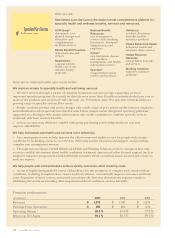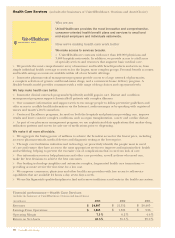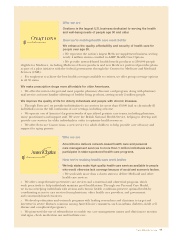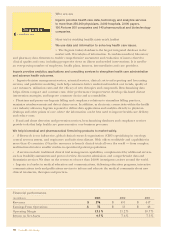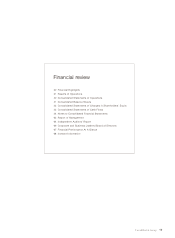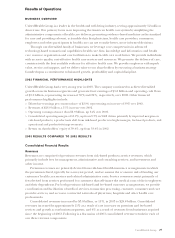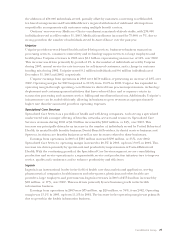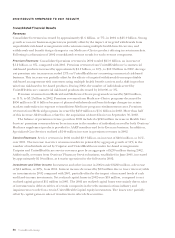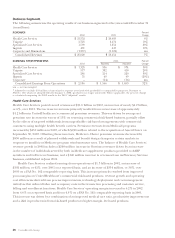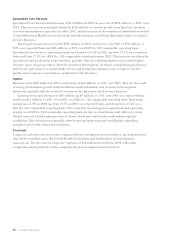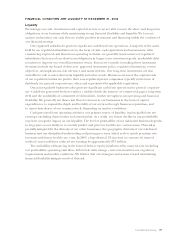United Healthcare 2003 Annual Report Download - page 24
Download and view the complete annual report
Please find page 24 of the 2003 United Healthcare annual report below. You can navigate through the pages in the report by either clicking on the pages listed below, or by using the keyword search tool below to find specific information within the annual report.
22 UnitedHealth Group
Premium Revenues Consolidated premium revenues in 2003 totaled $25.4 billion, an increase of
$3.5 billion, or 16%, over 2002. UnitedHealthcare premium revenues increased by $1.8 billion,
driven primarily by average premium rate increases of 12% to 13% on renewing commercial risk-based
business. Premium revenues from Medicaid programs also increased by approximately $1.0 billion
over 2002. Approximately 70% of this increase resulted from the acquisition of AmeriChoice on
September 30, 2002, with the remaining 30% driven by growth in the number of individuals served
by our AmeriChoice Medicaid programs since the acquisition date. The remaining premium revenue
growth in 2003 was primarily driven by growth in the number of individuals served by Ovations’
Medicare supplement products provided to AARP members and its Evercare business, along with
growth in several of Specialized Care Services’ businesses.
Service Revenues Service revenues in 2003 totaled $3.1 billion, an increase of $224 million, or 8%, over
2002. The increase in service revenues was driven primarily by aggregate growth of 7% in the number
of individuals served by Uniprise and UnitedHealthcare under fee-based arrangements during 2003.
Investment and Other Income Investment and other income totaled $257 million, representing an
increase of $37 million over 2002, due primarily to increased capital gains on sales of investments.
Net capital gains on sales of investments were $22 million in 2003, compared with net capital losses
of $18 million in 2002. Interest income decreased by $3 million in 2003, driven by lower yields on
investments, partially offset by the impact of increased levels of cash and fixed-income investments.
Medical Costs
The combination of pricing, benefit designs, consumer health care utilization and comprehensive
care facilitation efforts is reflected in the medical care ratio (medical costs as a percentage of
premium revenues).
The consolidated medical care ratio decreased from 83.0% in 2002 to 81.4% in 2003. Excluding the
AARP business,1the medical care ratio decreased 140 basis points from 81.4% in 2002 to 80.0% in 2003.
Approximately 30 basis points of the decrease in the medical care ratio was driven by favorable
development of prior period medical cost estimates as further discussed below. The balance of the
medical care ratio decrease resulted primarily from net premium rate increases that exceeded overall
medical benefit cost increases and changes in product, business and customer mix.
Each period, our operating results include the effects of revisions in medical cost estimates related
to all prior periods. Changes in medical cost estimates related to prior fiscal years that are identified in
the current year are included in total medical costs reported for the current fiscal year. Medical costs for
2003 include approximately $150 million of favorable medical cost development related to prior fiscal
years. Medical costs for 2002 include approximately $70 million of favorable medical cost development
related to prior fiscal years.
On an absolute dollar basis, 2003 medical costs increased $2.5 billion, or 14%, over 2002. The
increase was driven primarily by a rise in medical costs of approximately 10% to 11% due to medical cost
inflation and a moderate increase in health care consumption, and incremental medical costs related to
businesses acquired since the beginning of 2002.
1Management believes disclosure of the medical care ratio excluding the AARP business is meaningful since underwriting gains or
losses related to the AARP business accrue to AARP policyholders through a rate stabilization fund (RSF). Although the company is
at risk for underwriting losses to the extent cumulative net losses exceed the balance in the RSF, we have not been required to fund
any underwriting deficits to date and management believes the RSF balance is sufficient to cover potential future underwriting or
other risks associated with the contract during the foreseeable future.




